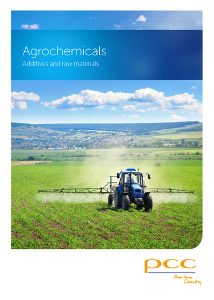First line PCC Group portfolio for the agrochemical sector covers a variety of surface active agents of different chemical structures. Surfactants in plant protection products may play multiple roles which, in effect, increase the yield of working solutions. This allows for the reduction of the amounts of pesticides used and, therefore, lowering costs related to agricultural production, as well as obtaining environmental benefits.

The share of agriculture in the economy of individual countries varies considerably, and employment levels in this sector range from a few per cent in highly developed countries to as much as several dozen per cent in countries with slower economic growth. Intensive agriculture, also known as industrial agriculture, has become more and more popular as the world’s population increases. It is focused on maximum yield and profit, using considerable financial outlays and significant chemicalisation and mechanisation. Obtaining adequate productivity levels in the industry is possible, inter alia, due to the application of proper chemicals.
Agrochemicals in agriculture
Agrochemicals comprise all chemical compounds used in agriculture, including pesticides, adjuvants, growth regulators, mineral fertilizers, as well as feed additives in animal husbandry. Plant protection products contain various different ingredients. Active substances used to control detrimental organisms and unwanted plants are some of the most important. Besides, these preparations can contain oils and organic solvents, as well as numerous functional additives with emulsifying, wetting, anti-freezing, anti-scaling, dispersing or anti-foaming properties. Adjuvants are a particularly important group of products used in plant cultivation. Their significance and popularity are constantly increasing due to the numerous benefits of their use. They cover all the substances of plant protection products or ingredients added directly to the tank of the sprayer. They are aimed at improving biological activity and the physicochemical properties of the spraying solution. An important role of adjuvants is to decrease the surface tension of the working solution, as this facilitates and improves the effectiveness of plant treatment and perfoliant fertilization. Increased adhesion of the preparation and enhanced spreading on the surface is necessary when plant leaves are covered with waxes. This is also of utmost importance due to the variety of shells which protect pest organisms, and prevent the spraying solution from penetrating into the organisms.
The surfactants range
Wetting agents are substances which efficiently reduce the surface tension of spraying solutions, therefore enhancing the spread of droplets on the surface of plants, ensuring homogeneous application. The presence of such agents increases the absorption of the preparation, which results in enhanced resistance to washout by rain. These agents are an important group of ingredients in liquid foliar fertilizers. The PCC Group range includes specifically developed additives, i.e., the EXOwet family of products, and ethoxylated fatty alcohols with very good wetting properties, such as the ROKAnol IT series (based on C-13 alcohol), ROKAnol ID products (based on C6–C12 alcohol), or ROKAnol NL products (C9–C11 alcohol derivatives).
Some adjuvants and plant protection products contain oils and organic solvents, which reduce their miscibility with water. To facilitate this process, the use of emulsifiers is necessary. These compounds, thanks to their amphiphilic structure, promote formation of emulsion by dispersion of hydrophobic phase particles in water. The PCC Group products with emulsifying properties first of all comprise the EXOemul products, i.e., blends of surface active agents used for the preparation of adjuvants (tank-mixes) based on mineral and vegetable oils and their derivatives, as well as blends for the emulsification of herbicides (e.g., EXOemul A3). Enrichment of formulation with appropriate amounts of specific surfactants, such as ethoxylated derivatives of fatty alcohols (ROKAnol products) or fatty acids (ROKAcet products) is also effective in improving miscibility with water.
Foaming of agrochemical preparations is highly undesirable; therefore, low-foaming surfactants are widely used. These agents exhibit good wetting and emulsifying properties as well. Our product range includes alkoxylated fatty alcohols, such as the ROKAnol NL8P4 and ROKAnol LP series. The PCC Group portfolio also contains block co-polymers (ROKAmer series), which, thanks to their structure, prevent foam formation in the system, at the same time providing dispersing and wetting properties. Due to their high efficacy, they are utilised, for example, in the sugar beet washing process.
Raw and intermediate products
The PCC Group range for the agrochemical sector is complemented by raw and intermediate chemical products. These are, for example, high purity phosphorus derivatives, such as phosphorous oxychloride and phosphorus trichloride, used as substrates in synthesis of some active substances (e.g., glyphosate). Monochloroacetic acid is applied in a similar way to manufacture 2,4-D, which is a widespread herbicide belonging to the growth regulator class. The PCC Group range also includes chloro derivatives of benzene, such as para-dichlorobenzene (PDCB). Upon contact with air, this compound sublimates and releases a strong odour, therefore it is an ingredient of insect repellents. What is more, the PCC Group is a manufacturer of chlorine, which is an important raw material in the production of a variety of chemical products, including insecticides. Another product is sulphuric acid, used in formulation of chemical fertilizers.

